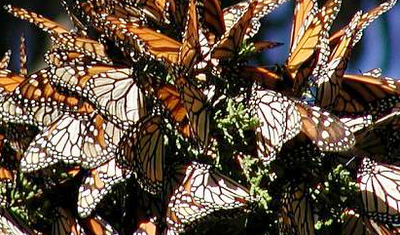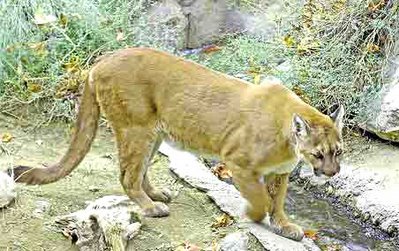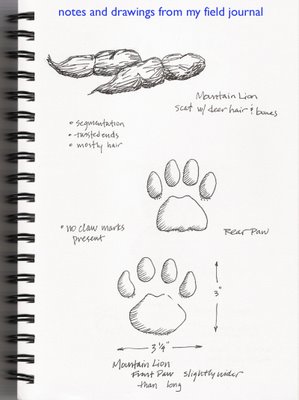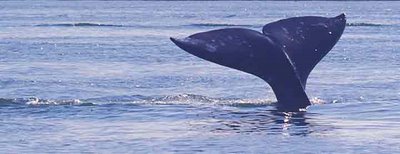Kings of the Kelp: California Sea Otters
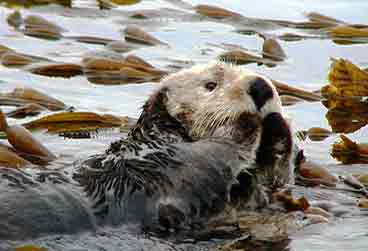
Clack, Clack, Clack… The rhythmic stony sound drifted over the crash of ocean waves. With curiosity I looked around sensing the sound of hammering did not belong in the direction of the sea. On second look, I saw that all of the brown spheres that I had presumed to be kelp were not. There in the rolling bed of kelp floated a dusky brown critter pounding away at its chest—I had heard my first sea otter before I had ever laid eyes on it.
The sea otter I was watching was showing off its unique ability to use tools. The otter floated on its back with a rock on its chest and a mussel in its paw. It hammered away until the hard-shelled mollusk broke open exposing the delicate flesh that is the otter’s food. When it was done with the meal the otter gracefully rolled over one full turn, dropping the rock back to the sea floor and cleaning up in one swift motion.
The California Sea Otter (Enhydra lutris nereis) is a streamlined brown furred member of the weasel family. The smallest of all the marine mammals adults weigh between 35 and 90 pounds and live 10 to 20 years with the males typically larger and the females living longer. Currently there are roughly 2700 individuals living along the nearshore waters between Point Conception and Half Moon Bay generally preferring places with kelp or the protected waters of harbors and sloughs.
With up to one million hairs per square inch the sea otter has the densest hair of all mammals. This thick hair is key to its survival as it is the only marine mammal without a blubber layer for insulation from the cold seawater. Air is trapped in the dense fur so the frigid ocean water never touches skin. Sea otters, if not sleeping or foraging, are almost always grooming their fur to retain its insulating abilities. As much as six hours a day is spent grooming. An otter that cannot groom itself will die from hypothermia.
If not grooming otter are voraciously foraging at an average of eight hours a day. Sea urchins, abalone, crabs, mussels, clams, make up some of the 40-plus species they opportunistically prey upon. They must eat 25 percent or more of their body weight to maintain their high metabolic rate and body temperature in the cold coastal waters (do the math and imagine if you had to find and eat 25 percent of your body weight each day)!
The remainder of their time is spent resting and sleeping. They wrap themselves in kelp as an anchor. The careful observer might spot both their head and hind flippers bobbing high out of the water as a heat conservation strategy. While sea kayaking I once unknowingly bumped into a well camouflaged sleeping otter. I let out a scream as the back of its body flopped onto the deck of my boat as it dove. I was certain that some unknown predator was attacking me. I’m sure the otter thought the same. Luckily, we both escaped unharmed.
Although they generally forage alone, otters are social animals. They will “raft” up while resting in groups as small as a half dozen to as large a few hundred. Males are most commonly found separate from females except when breeding. Frequently males further divide themselves between juvenile and adult groups although in smaller numbers than the female groups. Males tend to travel a greater distance within their territory and are often found at the edges of the sea otter range. Males engage in a playful courtship and will protect their breeding territory from other males when females are available for mating.
Female otters and their young can often be seen rafted together in one group. Young otters, typically born between January and March, will spend the first months with their mothers during which time they are depended on her for their survival. They must be fed, groomed, and taught how to forage. I have spent hours watching a mother and pup as they playfully worked their way through a kelp bed. The pup riding on the mother’s chest, and then suddenly, without apparent warning, the mother rolls to dive in search of food. Pups are so buoyant that they cannot dive and sit helplessly on the surface as floating balls of fur. From the time the mother submerges for food until she surfaces, the pup makes a high-pitched call that can be heard from a distance (the first time I heard this call I mistook it to be that of a sea bird). As the mother emerges she locates the pup by its cry. After feeding both herself and her pup a mother might groom her pup by blowing air into its fur. Pups are generally weaned from the mother’s care by 8 to 12 months.
The unique density of the otters fur is key to its survival and, historically, it was what almost brought the species to an end. From the mid 1700’s through the 1800’s expeditions of explorers and hunters reduced the California and Alaskan sea otter to near extinction. Otter skins were highly valued for their fine pelt and fetched exorbitant prices in the Russian and Chinese fur trade markets. The severe drop in the sea otter population was a significant part of why Russia decided Alaska had little value and sold it to the United States. By early 1900’s the sea otter was so rare that a ban was finally place on hunting them.
While it is believed that a couple of thousand Alaskan otters survived the intense hunting, the California sea otters were thought to be extinct. Many Big Sur locals knew about a small number along the coast but kept quiet about it. During the construction of the Bixby Creek Bridge in 1938 workmen regularly spotted a small group of sea otters. It was then that the scientific community “discovered” that the California sea otters still existed. The small group began to grow and spread its territory. The current population is descended from this original group. Being classified as “threatened” as an endangered species further protected them in 1977. The sea otter populations have slowly grown until the last years when their population declined or leveled-off. Scientists are both alarmed and puzzled over the exact cause this apparent plateau, as they should be growing in numbers and range. A constellation of factors including contaminants, lack of sufficient food, and disease may be the biggest culprits. Humans contribute unintentionally to these factors in a number of ways. Inappropriately disposing of cat litter is one example, as cats, both wild and domestic, can carry a parasite (toxoplasmosis) that once in otter habitat, can and does kill them.
The kelp forest habitat and the sea otter are intricately connected. When sea otters are taken out of their coastal kelp habitat sea urchins and other algae grazers proliferate. The larger kelps that create the forest decline, as does the whole chain of organisms depended on the kelp forest habitat. When sea otters return to this habitat their voracious feeding habits puts a check on the abundant algae grazers allowing the kelp forest to reestablish itself. As the kelp forests return the diversity of species increases. Sea otters are what ecologists call a keystone species. Without the sea otter we lose more than a cute teddy bear like animal of the sea that is so easy to love. We lose a whole living system and the many species that make this system home. As a keystone indicator species the otter can let us know when our coasts are fully restored and in healthy balance. When the California sea otters have re-inhabited their original range we will have 15,000 or more woven into the fabric of this rich coastal sea.
The Monterey Bay Aquarium, of course, is a good place to learn about and observe the otters in a world-class exhibit. That said, wild otters, are really worth the effort. My favorite place to watch wild sea otters is from any high spot along the rocky shoreline, especially in the kelp bed habitat. I strongly recommend binoculars or a spotting scope. Much like my first encounter with otters many newcomers mistake the large brown bulbs of the bull kelp as the heads of sea otters. Time and patience will reward you with and encounter you will remember… perhaps the feel of the sun on your back, the sound of breaking waves interwoven with the distinct smell of the sea. Then, perhaps—delight—as the clack, clack, clacking, draws your attention to a dining otter on the crest of a rising wave.
Labels: Big Sur, california, otter, sea otter
